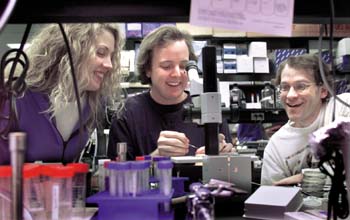
From left, Mary Kosinski, Michael Miller, and David Greenstein examine microscopic worms in the lab. Their findings were published in the March 16 Science. (photo by Dana Johnson)
Scientists pinpoint worm sex signal
When Michael A. Miller, Ph.D., went to The Home Depot looking for a vise, he had a hard time explaining what he wanted to do with the tool. Miller, a postdoctoral fellow in Cell Biology, wasn’t in the midst of a woodworking project; he was looking for lab equipment – something that would help him isolate a reproductive signal used by microscopic worms.
“The guy helping me looked confused and said, ‘Who did you say you were?’,” Miller recalled with a laugh.
Miller purchased the vise and succeeded in identifying the biological signal that sperm use to “talk” to eggs in nematodes, a class of worms that includes plant and animal parasites. The findings, reported March 16 in Science, shed light on oocyte maturation and could be exploited to develop parasite-fighting drugs.
The study of oocytes and how they mature has been critical to the discovery of important signaling pathways that control the cell cycle and cell division, said David I. Greenstein, Ph.D., associate professor of Cell Biology and senior author of the Science paper.
“We are a bit unusual in studying C. elegans (a type of worm) oocytes,” Greenstein said, “but we’re interested in the same fundamental questions of how the oocyte makes a crucial cell cycle transition and how that is coordinated with fertilization.”
In most animals, including worms and human beings, oocytes are arrested in an immature state until they receive a signal to reenter the cell cycle and mature. In the worm, sperm cells release a signal that stimulates both oocyte maturation and ovulation.
The investigators went after the signal using a biochemical approach – they purified the active signal in order to identify it. This is where the vise came in; Miller used it to isolate sperm from male worms sandwiched between two sheets of Plexiglas. He then incubated the sperm in a liquid medium to capture the signaling molecules they released.
Miller and Greenstein collaborated with Viet Nguyen, Ph.D., research fellow in Biochemistry, and Richard Caprioli, Ph.D., Stanley Cohen Professor of Biochemistry and director of the Mass Spectrometry Research Center, to purify and identify the protein.
“The high sensitivity of mass spectrometry for analyzing proteins and the availability of the complete sequence of the C. elegans genome made the identification process a lot easier than it would have been just a few years ago,” Miller said.
The signal the investigators identified turned out to be a well-known protein called major sperm cytoskeletal protein (MSP). Its signaling capacity was a complete surprise.
“MSP is a protein that’s been studied for the past 20 years, and there’s really a lot of information about it,” Miller said. “But this huge aspect of its function had been totally missed.”
“Other scientists who have been studying MSP for years didn’t want to believe that this protein was the signal for oocyte maturation and ovulation,” Greenstein said. “We had to do a lot of work to convince them that we were right.”
MSP had been characterized as a structural protein inside sperm, a protein important to sperm motility. Miller and Greenstein’s findings show that it also functions outside the sperm, to let the oocyte know it’s time for fertilization. How it gets out of the sperm is still a mystery. It is the first example, though, of a protein that functions both inside and outside the cell, they said. And it could be the first member of a new family of signaling molecules.
“There are proteins in us that have MSP-like domains and might have similar signaling capabilities,” Greenstein said. “It’s possible that MSP is the tip of the iceberg of a new type of signaling molecules.”
Whether or not MSP-like molecules play signaling roles in other organisms, they are crucial to nematode reproduction. And because MSP hasn’t changed very much during millions of years of worm evolution, Miller and Greenstein said, it could be a good target for anti-helminthic therapeutics-drugs that fight parasite infections.
The story of MSP action is in its first chapter. The group currently is working to identify the MSP receptor and subsequent signaling pathways.
“By identifying the signal, we have basically opened a window on all this really fascinating biology,” Greenstein said. “We think we may learn a lot about meiotic arrest in oocytes and more generally about signals that control cell cycle transitions.”
Miller and Greenstein’s discovery of an entirely new function for an already well characterized protein should serve as a “poignant cautionary tale for biologists everywhere,” Anne M. Villeneuve, Ph.D., of Stanford University, wrote in a commentary accompanying the Science paper. “Proteins that we think we know extremely well may turn out to be leading dual lives!,” she wrote.
Other authors of the Science paper include Mary Kosinski, a graduate student in Cell Biology, and Min-Ho Lee and Tim Schedl in the department of Genetics at the Washington University School of Medicine. The research was supported by the National Institutes of Health.













